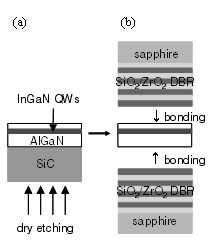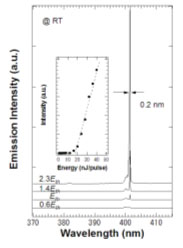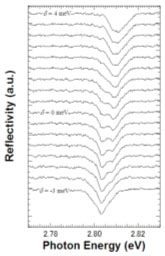1Optical Science Laboratory, 2Materials Science Laboratory
Cavity polaritons are quasi-particles that are created
by strong exciton-photon coupling in a semiconductor quantum well (QW) microcavity.
In recent years, much attention has been directed to the behavior of these
cavity polaritons as composite bosons at sufficiently small densities. One
area of interest relates to polariton devices that employ bosonic behavior,
such as the threshold-less “polariton” laser. To achieve these devices and
room temperature operation, we have to choose materials that have large oscillator
strength and a large exciton binding energy.
GaN-based semiconductors have a large exciton binding energy, and this energy
allows excitons to exist even at room temperature. Moreover, the oscillator
strength of this system will be larger than that of typical III-V semiconductors
owing to the large effective mass of nitrides. Therefore, we can expect very
strong exciton-photon coupling in GaN-based QW microcavities that will enable
us to achieve polariton devices that operate above room temperature.
We used smooth and crack-free InGaN QW microcavities to realize strong coupling.
The microcavities were fabricated using a wafer bonding technique with an
InGaN/AlGaN QW layer and dielectric DBRs (Fig. 1). We observed a lasing action
in the fabricated microcavity as shown in Fig. 2 [1]. Figure 3 shows the reflection
spectra of the QW microcavities for various degrees of cavity detuning (δ).
We observed the appearance and disappearance of splitting and these positions
varied with δ. This behavior is evidence of cavity polariton formation, and
the vacuum-field Rabi splitting which reflects the strength of the exciton-photon
coupling is about 6 meV. We deduced from these results that the oscillator
strength of InGaN QW excitons is one order of magnitude larger than that of
GaAs QW excitons. These results indicate that GaN-based semiconductors are
advantageous for studying the polaritonic effect and its device applications.
[1] T. Tawara, et al., Appl. Phys. Lett. 83 (2003) 830.
[2] T. Tawara, et al., Phys. Rev. Lett. 92 (2004) 256402.
 |
 |
 |
| Fig. 1. Fabrication. |
Fig. 2. Lasing by optical pumping. |
Fig. 3. Formation of cavity polariton. |